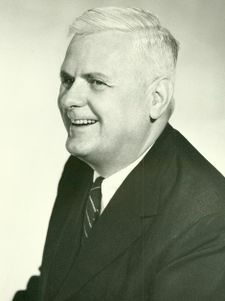Alonzo Church
| Alonzo Church | |
|---|---|
 Alonzo Church (1903–1995)
|
|
| Born | June 14, 1903 Washington, D.C., USA |
| Died | November 8, 1995 (aged 92) Hudson, Ohio, USA |
| Residence | United States |
| Nationality | American |
| Fields | Mathematics, Logic |
| Institutions | Princeton University 1929–67 University of California, Los Angeles 1967–95 |
| Alma mater | Princeton University |
| Doctoral advisor | Oswald Veblen |
| Doctoral students | C. Anthony Anderson Peter Andrews George Alfred Barnard Martin Davis Leon Henkin David Kaplan John George Kemeny Stephen Kleene Michael O. Rabin Hartley Rogers, Jr J. Barkley Rosser Nathan Salmon Dana Scott Raymond Smullyan Alan Turing |
| Known for | Lambda calculus Church–Turing thesis Frege–Church ontology Church–Rosser theorem |
Alonzo Church (June 14, 1903 – August 11, 1995) was an American mathematician and logician who made major contributions to mathematical logic and the foundations of theoretical computer science. He is best known for the lambda calculus, Church–Turing thesis, Frege–Church ontology, and the Church–Rosser theorem.
Contents |
Life
Alonzo Church was born on June 14, 1903 in Washington, D.C. where his father, Samuel Robbins Church, was the Justice of the Municipal Court for the District of Columbia. The family later moved to Virginia after his father lost this position because of failing eyesight. With help from his uncle, also named Alonzo Church, he was able to attend the Ridgefield School for Boys in Ridgefield, Connecticut.[1] After graduating from Ridgefield in 1920, Church attended Princeton University where he was an exceptional student, publishing his first paper, on Lorentz transformation, and graduating in 1924 with a degree in mathematics. He stayed on at Princeton, earning a Ph.D. in mathematics in three years under Oswald Veblen.
He married Mary Julia Kuczinski in 1925 and the couple had three children, Alonzo Church, Jr. (1929), Mary Ann (1933) and Mildred (1938).
After receiving his Ph.D. he taught briefly as an instructor at the University of Chicago and then received a two-year National Research Fellowship. This allowed him to attend Harvard University in 1927–1928 and then both University of Göttingen and University of Amsterdam the following year. He taught at Princeton, 1929–1967, and at the University of California, Los Angeles, 1967–1990. In 1990, he received the Doctor Honoris Causa from the State University of New York at Buffalo in connection with an international symposium in his honor organized by John Corcoran.[2] He had previously received honorary doctorates from Case Western Reserve University (1969) and Princeton University (1985).[3]
He died in 1995 and was buried in Princeton Cemetery.
Mathematical work
Church is best known for the following accomplishments:
- His proof that Peano arithmetic and first-order logic are undecidable. The latter result is known as Church's theorem.
- His articulation of what has come to be known as Church–Turing thesis.
- He was the founding editor of the Journal of Symbolic Logic, editing its reviews section until 1979.
- His creation of the lambda calculus.
The lambda calculus emerged in his famous 1936 paper showing the existence of an "undecidable problem". This result preceded Alan Turing's famous work on the halting problem, which also demonstrated the existence of a problem unsolvable by mechanical means. Church and Turing then showed that the lambda calculus and the Turing machine used in Turing's halting problem were equivalent in capabilities, and subsequently demonstrated a variety of alternative "mechanical processes for computation." This resulted in the Church–Turing thesis.
The lambda calculus influenced the design of the LISP programming language and functional programming languages in general. The Church encoding is named in his honor.
Students
Church's doctoral students are an extraordinarily accomplished lot, including C. Anthony Anderson, Peter B. Andrews, George A. Barnard, William W. Boone, Martin Davis, Alfred L. Foster, Leon Henkin, John G. Kemeny, Stephen C. Kleene, Simon B. Kochen, Maurice L'Abbé, Isaac Malitz, Gary Mar, Michael O. Rabin, Nicholas Rescher, Hartley Rogers, Jr., J. Barkley Rosser, Dana Scott, Raymond Smullyan, and Alan Turing. See [1]. A more complete list is at [2] as part of the Mathematics Genealogy Project.
Books
- Alonzo Church, Introduction to Mathematical Logic (ISBN 978-0-691-02906-1)
- Alonzo Church, The Calculi of Lambda-Conversion (ISBN 978-0-691-08394-0)
- Alonzo Church, A Bibliography of Symbolic Logic, 1666–1935 (ISBN 978-0-8218-0084-3)
- C. Anthony Anderson and Michael Zelëny, editors, Logic, Meaning and Computation: Essays in Memory of Alonzo Church (ISBN 978-1-4020-0141-3)
See also
- Church–Turing–Deutsch principle
- Higher-order logic
- Universal set
Footnotes
- ↑ The Ridgefield School for Boys, also known as the Ridgefield School, was a private school that existed from 1907 to 1938. See The Ridgefield School.
- ↑ Buffalo Logic Colloquium: past conferences
- ↑ Honorary degrees awarded by Princeton University
Sources
- Enderton, Herbert B., Alonzo Church: Life and Work. Introduction to the Collected Works of Alonzo Church, MIT Press, not yet published.
- Enderton, Herbert B., In memoriam: Alonzo Church, The Bulletin of Symbolic Logic, vol. 1, no. 4 (Dec. 1995), pp. 486–488.
- Wade, Nicholas, Alonzo Church, 92, Theorist of the Limits of Mathematics (obituary), The New York Times, September 5, 1995, p. B6.
- Hodges, Wilfred, Obituary: Alonzo Church, The Independent (London), September 14, 1995.
- Alonzo Church interviewed by William Aspray on 17 May 1984. The Princeton Mathematics Community in the 1930s: An Oral-History Project, transcript number 5.
- Rota, Gian-Carlo, Fine Hall in its golden age: Remembrances of Princeton in the early fifties. In A Century of Mathematics in America, Part II, edited by Peter Duren, AMS History of Mathematics, vol 2, American Mathematical Society, 1989, pp. 223–226. Also available here.
External links
- O'Connor, John J.; Robertson, Edmund F., "Alonzo Church", MacTutor History of Mathematics archive, University of St Andrews, http://www-history.mcs.st-andrews.ac.uk/Biographies/Church.html.
- Alonzo Church at the Mathematics Genealogy Project
- Princeton University Library, Manuscripts Division, The Alonzo Church Papers, 1924–1995: finding aid.
- A bibliography of Church's reviews for The Journal of Symbolic Logic, with a link to each
|
||||||||||||||||||||||||||||||||||||||||||||||||||||||||||||||||||||||||||||||||||||||||||||||||||||||||||||||||||||